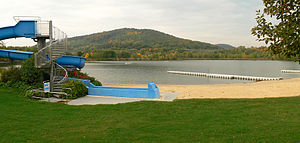Stock pool
| Stock pool | ||
|---|---|---|

|
||
| Beach at the Stockelache | ||
| Geographical location | West Hessian valley | |
| Places on the shore | Arnsbach , Kerstenhausen , Kleinenglis | |
| Location close to the shore | Borken (Hesse) | |
| Data | ||
| Coordinates | 51 ° 3 '52 " N , 9 ° 14' 34" E | |
|
|
||
| Altitude above sea level | 185 m | |
| surface | 10 ha | |
| length | 320 m | |
| width | 255 m | |
|
particularities |
||
The Stockelache is an artificial bathing lake between the Borken districts of Kleinenglis , Kerstenhausen and Arnsbach that was created after the cessation of lignite mining in the Borken lignite area in a residual open pit (formerly Stockelache pit ) .
location
The Stockelache is located immediately east of the Schwalmpforte on the north bank of the Schwalm directly on the B 3 Fritzlar - Jesberg near the Borken junction of the A 49 . The state road 3223 leading from Borken to the motorway junction and the B 3 runs 200 m north of the lake, the district road 73 from Kerstenhausen to Arnsbach and Borken 300 m not far to the southwest. The lake can be reached by bike via the R4 / Schwalm-Radweg , R5 and R101 cycle paths .
In the northwest the Hundsburg rises ( 334.9 m above sea level ), in the southwest the Kuhberg ( 342.9 m ), a northeastern branch of the Altenburg ( 432.7 m ). The Altenburg Kippe ( 214.9 m ) rises to the south-east , a renatured high dump made of overburden from the purest opencast mine.
Surname
Stockelache is a modification of Stocklache . In Schwalm arc west of the former floor Lacher mill where now the lake, the river in flooded flood the local meadows . After the flood, the water stopped in the deeper here lying meadows and, after some time, foxing , leading to the hall designation floor pool (storied = Pool ) led.
Emergence
From 1976 to 1985, the Stockelache opencast mine was operated on an area of 28 hectares . The coal seam had a thickness of up to 8.3 m and lay under overburden up to 42.3 m thick . A total of around 360,000 t of lignite was extracted there, with around 1.85 million m³ of overburden having to be moved. After the carbonization, a residual hole remained, in which a lake with a water surface of approx. 10 ha and a maximum depth of 20 m was created by the penetration of groundwater. The edge areas of the former open-cast mine were re-cultivated in the north and west , and the bank area was planted with greenery.
After the mining recultivation measures were completed in the 1980s, the city of Borken acquired the lake and the surrounding area and had the facilities necessary for recreational use created through its own operation " Borkener Seenland ". The resulting bathing lake is very popular in the region. In addition to the sandy beach, bathing islands, non-swimmers' area, 50-meter water slide and fountains, there are four beach volleyball fields, pedal boat rental , an adventure playground, barbecue areas , a large sunbathing area, changing rooms with sanitary facilities, a restaurant with a beer garden and sufficient parking spaces, also for bicycles .
Triathlon
As a regular sporting event, the Stockelache Triathlon of the TuS Fritzlar sports club took place annually around the Stockelache from 1992 to 2008 . After a five-year break, the Stockelache triathlon (sprint distance: 750 m swimming, 22 km cycling, 5 km running) was only held again in 2014, now by Celtic Sports eV Neuental .
Overhead line masts
Directly on the north-western and north-eastern shores of the lake, two lattice masts , which today are not roped, catch the eye. When the line was dismantled at the end of the 1980s, these two masts were bought by the city of Borken for possible installations around the Stockelache and were therefore preserved.
Web links
Individual evidence
- ↑ The mill was demolished in 1977.
- ↑ New beginning at the Stockelache. In: HNA . September 2, 2014, accessed January 24, 2016 .
- ↑ according to request from the former operator for discussion: 220 kV line Lehrte – Borken

